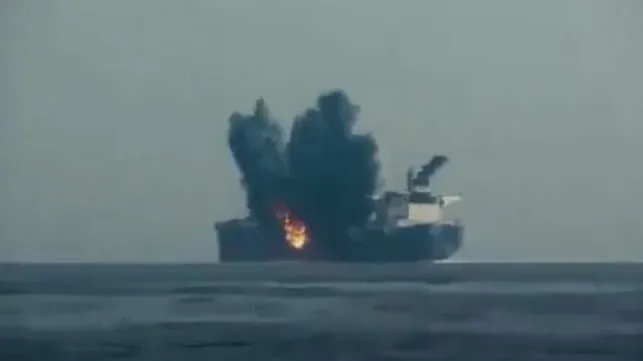Houthi Attack on Tanker Cordelia Moon: A Comprehensive Analysis of the Incident and Its Implications

The Red Sea has long been a hotspot for geopolitical tensions, with the shipping lanes in this region being a critical artery for global oil and trade. On October 1, 2024, these tensions manifested once again when the crude oil tanker Cordelia Moon (163,288 dwt) came under a coordinated attack orchestrated by the Houthi group.
This assault, carried out with a combination of ballistic missiles, drones, and an explosive-laden surface boat, demonstrates the evolving and escalating threats to commercial shipping in the region.
🚨Exclusive video on the Sept 30, 2024 #Houthi attack on the tanker Cordelia Moon heading north in the #RedSea 🚨
— Sal Mercogliano (WGOW Shipping) 🚢⚓🐪🚒🏴☠️ (@mercoglianos) October 2, 2024
Check out my full video at: https://t.co/e6HBbXDxdC https://t.co/rLdInUBsU8 pic.twitter.com/sKqZtqUPKb
The Attack Unfolds: A Multi-Pronged Assault
The Cordelia Moon, an empty crude oil tanker registered in Panama and managed by an Indian firm, was navigating north through the Red Sea, bound for the Suez Canal when it came under fire. The vessel was approximately 64 nautical miles north of Hudaydah, Yemen—a region known for frequent Houthi activity—when the attack began.
According to Houthi sources, the group initiated the attack with a barrage of eight ballistic and "winged" missiles, drones, and an uncrewed surface boat packed with explosives. The Houthis, who claimed responsibility for the attack, identified the tanker as a British vessel, although it is registered in Panama. This assault was not a random occurrence; rather, it was part of a broader series of targeted attacks on maritime traffic in the region.
The captain of the Cordelia Moon initially reported four splashes in the water, indicative of missile fire, before noticing the approach of a drone boat on the port side. This boat, armed with explosives, was heading straight for the vessel, adding an air of urgency and danger to the situation.
⚡️The moment of the attack from another angle, the Houthi kamikaze sea drone on the 🇬🇧British oil tanker "Cordelia Moon" in the Red Sea pic.twitter.com/Zg0UkhfouK
— 🪖MilitaryNewsUA🇺🇦 (@front_ukrainian) October 3, 2024
Security Response: A Valiant but Incomplete Effort
The crew of the Cordelia Moon included armed security personnel, a standard measure for vessels traveling through high-risk zones such as the Red Sea. As the drone boat approached, the security team sprang into action, with one of the guards opening fire in an attempt to neutralize the threat. Videos obtained by maritime commentator Sal Mercogliano show the guard’s repeated efforts to disable the drone boat, yet despite multiple shots, the boat continued its trajectory.
In a tense sequence of events captured on video, the drone boat eventually made contact with the tanker. The impact punctured the number six ballast tank of the vessel, causing a significant explosion. Although the tanker was not carrying oil at the time, the blast still posed serious risks to the integrity of the vessel and the safety of the crew.
Post-explosion footage from the Cordelia Moon shows the crew swiftly engaging damage control measures. Fire hoses were used to spray water over the side of the ship in an attempt to disperse any potentially harmful vapors, a common practice to prevent the ignition of flammable gases following such incidents. The crew's quick action likely played a critical role in ensuring that the damage did not escalate.
The Houthis’ Perspective: A Calculated Strike
From the perspective of the Houthi forces, the attack was a calculated and well-coordinated strike. Videos released by the group show the drone boat closing in on the Cordelia Moon and making contact, followed by a large plume of smoke from the resulting explosion. The footage is chilling, providing a stark reminder of the destructive capabilities of modern warfare technology even when deployed by non-state actors like the Houthis.
In the wake of the attack, Houthi spokesperson Yahya Saree issued a statement taking responsibility for the incident. Saree also made it clear that these attacks would continue, linking the ongoing assaults to broader regional conflicts, particularly the military actions in Gaza and Lebanon. The group's leader, Abdul-Malik al-Houthi, doubled down on this message, claiming that the Houthis had now attacked a total of 188 vessels and would not cease their activities until their conditions were met. These statements reflect the broader geopolitical context of the region, where maritime vessels have increasingly become pawns in a larger, more dangerous game of political brinksmanship.